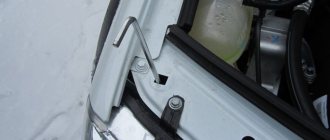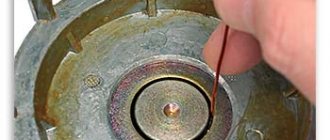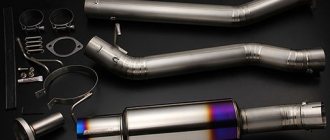The appearance of the Samara family (originally Sputnik) in AvtoVAZ production was a real breakthrough for the domestic automotive industry of that time. The three-door hatchback VAZ-2108, which debuted in 1984, created a real sensation among Soviet car enthusiasts. Stylish design, advanced production technologies, outstanding driving performance - all this led to resounding success. And this despite the fact that the body of the three-door hatchback clearly did not correspond to the utilitarian preferences of car enthusiasts of that time. The new model gained enormous popularity, and its design even received its own nickname – “chisel” – due to its characteristic silhouette.
In 1987, model 2109 was released - a five-door hatchback based on the V8. While retaining all its advantages and features, it was more suitable for the role of a family car. This only cemented the success. Later, the family was expanded to include a four-door sedan. With minor changes, the first generation remained on the production line until 2004.
The second generation of the Samara-2 family is, in fact, a restyling of the first generation models. The front part of the body was redesigned, the lighting equipment and some visual elements of the exterior design were changed. The interior also received changes in the form of a new panel (the so-called “euro-panel”), as well as improvements to some elements.
Line of power units VAZ-2114 (Samara-2)
During production, various modifications of engines already known from other models of the manufacturer were installed on models of the Samara-2 family. The widest choice was offered by model 2114, the successor to the legendary VAZ-2109 “nine”.
All engines that were equipped with the “fourteenth” are in-line naturally aspirated fours. The carburetor power system was gradually becoming a thing of the past, so the restyled successor to the “nine” is found exclusively in injection versions. This made it possible to modernize the engines and comply with environmental standards.
- 1.5 l. 8th grade (77 hp) – index 2111;
- 1.6 l. 8th grade (81 hp) – index 21114/11183;
- 1.6 l. 16th grade (89 hp) – index 21124;
- 1.6 l. 16th grade (98 hp) – index 21126.
Engine 2111 (1.5 l., 8 valves)
At its core, the engine is a redesigned modification of the well-known 21083 unit, which appeared on the legendary G8. The processing affected, first of all, the food system. Instead of a carburetor system, the engine began to be equipped with an injection system. The design of the connecting rod and camshaft also received changes. All this made it possible to improve technical characteristics. Power and torque have increased. In addition, the engine began to comply with Euro-2 environmental standards.
Gas distribution mechanism with overhead camshaft and belt drive. Its nice feature is that if the valve belt breaks, it is not susceptible to damage.
Typical problems
Floating idle speed most often occurs due to malfunction of the following components:
- Idle air control;
- Throttle position sensor;
- Vacuum booster.
If the existing symptoms are supplemented by the fact that the engine stalls while driving, then you should also pay attention to the condition of the mass air flow sensor (MAF).
If the engine begins to run unevenly and “triple”, then first of all you should pay attention to the compression indicators. Noticeably lower compression in one of the cylinders most likely indicates a burnt out valve. If the spread is small or exists in several cylinders, then the valve clearances should be checked. There is a high probability that they require adjustment. A similar symptom may also indicate problems with the gasket between the cylinder head and the cylinder block. However, even if such symptoms are not observed, do not forget to regularly check the thermal clearances of the valves, as well as adjust them. The manufacturer recommends performing this check every 20 thousand km. If everything is fine with compression, but there are similar symptoms, you need to check the ignition module.
Often noises and knocks become companions of this motor. All of this can be caused by out-of-adjustment valves. If you experience an increasing loud, dull metallic sound when you press the gas pedal, the engine will most likely need to be repaired. There are several main reasons for this symptom:
- Knock of main bearings;
- Knock of connecting rod bearings;
- Knock of pistons.
The operating coolant temperature range for this unit is 95-103 degrees. However, there are often cases when the engine simply does not heat up to such levels. The main reason for this behavior of the motor is a malfunction of the thermostat. Some owners have to replace it almost on a regular basis. All this is a consequence of the low quality of spare parts.
Other common malfunctions of this engine
- Valve cover leaks;
- Wear of cooling system components;
- Failures of the injection system on old copies;
- Breaking off the fastenings of the exhaust exhaust pipe (can be treated by replacing the steel threaded connections with brass ones).
The engine is very common and deservedly popular among many car enthusiasts. Its simplicity, maintainability and good knowledge make it easy to cope with existing shortcomings and characteristic malfunctions.
The manufacturer officially declares a resource of 150 thousand km. However, practice shows that many specimens are nursed deep beyond 200 thousand km. A lot depends on operating conditions and attention to maintenance.
Engine 21114/11183 (1.6 l. 8 cells)
The unit is a continuation of the development of the motor with index 2114, and accordingly its progenitor 21083, which was installed on the first generation of the Sputnik/Samara family. The changes affected mainly the cylinder block. Its height has increased, and accordingly the piston stroke has increased. The working volume has increased to 1.6 liters. Performance in terms of power and torque has also increased. In practice, this manifests itself in the form of improved elasticity and greater traction. The modifications made allowed the engine to comply with Euro-3 environmental standards.
Car owners can call this engine different names. You can find such names as engine 2114 (out of habit with an 8-valve Euro-2 valve), “Kalina”, as well as those corresponding to the official indices 21114 and 11183. The differences between engines with these two indices are that they were produced on different assembly lines.
The huge similarity with the 2111 engine endowed this unit with almost identical problems and malfunctions. It is also necessary to regularly monitor the condition of the valves and combat uneven operation.
One of the unpleasant individual features is the noisy operation, similar to the sound of a diesel engine. With other noises, things are the same as in the 2111 engine.
However, despite the common roots and problems, experts note that 21114/11183 is still a little less capricious. At the same time, there is still no risk of bending the valves if the timing belt breaks.
The motors are also similar in terms of service life. Thus, the manufacturer indicates 150 thousand km before major repairs, but in practice the figures easily exceed 200 thousand km, and sometimes reach 300 thousand.
BY COLOR NUMBER
| Color code | Name | Approximate view | Metallic | Description |
| 105 | Franconia | + | dark cherry-raspberry | |
| 190 | California poppy | + | golden red | |
| 192 | port wine | + | dark cherry | |
| 206 | melt water | + | light gray | |
| 230 | pearl | + | silver-white-milky | |
| 235 | beige | beige | ||
| 239 | Nevada | + | silver gray beige | |
| 240 | White cloud | white | ||
| 262 | bronze age | + | beige-brown | |
| 270 | Nefertiti | + | silver-beige | |
| 281 | crystal | + | light gray | |
| 290 | South Cross | + | grey-beige | |
| 347 | inca gold | + | golden dark green | |
| 360 | Sochi | + | grey-blue-green | |
| 363 | tsunami | + | dark green | |
| 391 | Robin Hood | + | black with emerald green tint | |
| 412 | regatta | + | silver-dark blue | |
| 426 | muscari | + | Navy blue | |
| 429 | Perseus | + | Navy blue | |
| 453 | capris | + | dark blue-green | |
| 495 | Moonlight | + | light blue | |
| 499 | Riviera | + | blue-violet | |
| 513 | black Pearl | + | silver brown | |
| 606 | Milky Way | + | graphite metallic | |
| 627 | honeysuckle | ? | steel gray | |
| 328 | Nice | + | dark blue-green | |
| 630 | quartz | + | medium gray-green | |
| 633 | borneo | + | dark silver gray | |
| 660 | altair | + | silver light gray | |
| 665 | space | + | blue-black | |
| 690 | snow. Queen | + | silver | |
| 790 | coriander | + | golden brown |
Engine 21124 (1.6 l., 16 valves)
The engine with index 21124 was replaced by unit 2112 on the conveyor. The sixteen-valve “four” increased its volume to 1.6 liters due to the use of a “high Kalinovsky” cylinder block. Modifications were made to comply with Euro-3 environmental standards. Thanks to this, traction at low speeds increased, but at the same time it became calmer in character. Compared to the “twelfth”, the noise level has increased.
The problem that was most feared by the owners of the sixteen-valve engine of the previous generation with index 2112 was solved. Thanks to the special design of the pistons with holes, the valves will not bend if the timing belt breaks. This is a significant advantage compared to the “twelfth”.
Thanks to the presence of hydraulic compensators, there is no longer a need to constantly monitor the thermal clearances of the valves. However, these parts are most often the cause of unpleasant knocking noises from under the hood. In addition, the cause of the knocking may be a problem with oil pressure. Moreover, the indicators can be either lower or higher than normal.
The old problem with valve adjustment was replaced by a new one. It is recommended to monitor the tension of the timing belt and tighten it every 15 thousand km.
There are also problems with knocking of a different nature. They can be called “branded” for VAZ engines. This is a knock from the main and connecting rod bearings, as well as from the pistons.
The engine is not without other “proprietary” faults:
- Floating speed;
- The engine “troits”;
- Stalls at idle or while driving;
- Temperature problems.
All these problems are familiar from other units. For example, for the same 2111. The roots of the problems are common, so the solutions can be found in the corresponding section of this article.
If the car does not start at all, then the check must be carried out according to the following scheme:
- Starter and battery;
- Ignition system;
- Power supply system and fuel pump.
If there are problems with traction, and specifically with its decrease, you should check the pressure in the fuel rail, as well as the condition of the injectors. Perhaps their filters are clogged.
A characteristic feature of the engine was increased vibration. There can be many reasons for this. Among them are the idle speed regulator, high-voltage wires, spark plugs, and a lambda probe. And this is not a complete list. To identify the cause, you will need a high-quality diagnosis from an experienced technician.
This engine easily overcomes the standard resource indicators from the manufacturer of 150 thousand km. According to the experience of the owners, most specimens easily last more than 250 thousand km. In addition, in a secret rating this engine model is considered one of the most successful from VAZ. This becomes especially important for owners who prefer to tune and modify the engine of their car.
Maintenance schedule
To avoid having to carry out expensive overhauls of the Lada Samara 2114 yourself, you should follow the manufacturer’s recommendations for servicing the internal combustion engine:
| Maintenance object | Time or mileage (whichever comes first) |
| Timing belt | replacement after 100,000 km |
| Battery | 1 year/20000 |
| Valve clearance | 2 years/20000 |
| Crankcase ventilation | 2 years/20000 |
| Belts that drive attachments | 2 years/20000 |
| Fuel line and tank cap | 2 years/40000 |
| Motor oil | 1 year/10000 |
| Oil filter | 1 year/10000 |
| Air filter | 1 – 2 years/40000 |
| Fuel filter | 4 years/40000 |
| Heating/Cooling Fittings and Hoses | 2 years/40000 |
| Coolant | 2 years/40000 |
| Oxygen sensor | 100000 |
| Spark plug | 1 – 2 years/20000 |
| Exhaust manifold | 1 year |
If consumables are replaced within the recommended time frame, the operational life of the internal combustion engine will increase.
Engine 21126 “Priora” (1.6 l., 16 cl.)
A continuation of the evolution of VAZ 16-valve engines was the engine with index 21126. It is a development of 21124, but with some changes. Among them:
- Lightweight ShPG (connecting rod and piston group);
- Better surface treatment;
- Honing of cylinders with more stringent requirements.
The timing drive is a belt drive with overhead camshafts. But unlike its predecessor, when it breaks, the valve bends. There is a radical solution to this design feature - replacing the pistons. If the engine is of a standard design, then you just need to carefully monitor the condition of the belt. Moreover, the problem with its weakening was solved by installing an automatic tensioner. The type of belt used was also changed.
Typical faults
If you feel a loss of power, then most often the reasons for this are the following phenomena:
- Loss of compression due to a burnt-out cylinder head gasket;
- Wear of the cylinder wall;
- Wear of piston rings;
- Piston burnout.
The result of unstable operation and refusal to start may be a problem with pressure in the fuel system. In addition, such symptoms are caused by sensor malfunctions, air leaks through leaky hoses or their connections, timing problems, or problems with the throttle valve.
If the engine is clearly “troubling”, then, first of all, it is necessary to check the compression readings to eliminate the problem of valve burnout. But more often this is caused by faulty spark plugs or a malfunctioning ignition coil. Sometimes the reason lies in the condition of the injectors, namely in the degree of their contamination.
Floating speed is a completely typical disease of VAZ 16-valve engines. Often, in addition to this, the engine runs unevenly. In this case, first of all, it is necessary to check the mass air flow sensor (MAF). If it is working properly, then most likely the cause is the throttle valve. It is necessary to clean it, and possibly replace its position sensor (TPS). At the same time, you should check the condition of the idle air control (IAC).
This engine was not without its signature headache with the thermostat. It also becomes the reason that the engine cannot warm up to operating temperature. However, if there is severe frost outside, perhaps the old-fashioned method of using cardboard in front of the radiator will help.
Some characteristic problems of other VAZ engines migrated to the 21126 Priora. So, if you detect knocking noises under the hood, you should first check the condition of the hydraulic compensators. Most often, they are the culprits of unpleasant knocking noises. At the same time, knocking noises that are associated with main and connecting rod bearings, as well as pistons, familiar from other VAZ engines, can also occur. This is already a serious malfunction, which is fraught with difficult engine repairs.
Minor problems, such as refusal to start, most often lie in the following malfunctions:
- Starter and battery;
- Ignition coil;
- Candles;
- Fuel pump malfunction;
- Clogged fuel filter;
- Faulty fuel pressure regulator.
Having improved its technical characteristics, the 21126 motor is still slightly inferior to its predecessor 21124 in reliability. Although it cannot be said that it is inferior very significantly. This is mainly due to the more complex design. Nevertheless, it is one of the best domestic engines, which also fits into modern environmental standards.
The declared resource is 200 thousand km. Compared to the officially declared resources of its predecessors, it has increased. However, in practice, older motors with a simpler design generally last longer. If we judge by reviews of actual use, then on average the actual resource corresponds to that specified by the manufacturer. Sometimes it can be more, sometimes less. Much depends on operating conditions and level of service.
Owner reviews
VAZ 2114 continued the tradition, and like its predecessor, it became a truly people's car. At one time it was the most affordable offer among non-mileage vehicles. This allowed it to become widespread and take its rightful place among other popular VAZ models.
Maksim. Lada 2114 1.6 l. 8th grade, 2010 180,000 km
I bought a car in 2015. The mileage on this example was quite decent, but the condition is good. I settled on the version with an 8-valve engine. Power is not so important for me, but they are considered much more reliable.
In general, this is confirmed so far. I only let you down once. When the temperature dropped below 30 degrees in winter, the battery died. But in fairness, it’s not entirely correct to make claims against the car itself.
Among the repair work, I did the replacement of the master brake cylinder and vacuum booster. We also had to change almost all the hoses under the hood. I recently had to replace the heater radiator. The rest is just consumables. I change the oil every 6-7 thousand, I only use synthetics. Many people do this on much higher mileages, but I like to play it safe. Moreover, given the quality of our fuels and lubricants, this will not be superfluous.
Among the shortcomings, we can note the quality of spare parts. Original spare parts from the factory do not serve flawlessly, but they have some margin of safety. Among the new ones there is a lot of different rubbish and defects. And this despite the fact that I try to buy the highest quality possible and not save. However, their “life” is very short. This is very frustrating and stressful. So I started thinking about selling.
Andrey. Lada 2114 1.6 l. 8th grade, 2008, 150,000 km
This car came to me unexpectedly. I was looking for a temporary second car for the family and settled on this option. I thought it wouldn’t be for long, but it turned out that I drove it for five years. All because I had to sell my main car. When purchased, the mileage was about 65 thousand.
There is not much to say about the ownership experience. A simple and unpretentious car. There are minimal amenities, but it doesn’t cause any trouble either. There is a minimum of electronics and electrics, and as a result it is quite reliable.
I didn’t have any breakdowns that would make it stand up straight on the road. I changed the clutch, replaced the timing belt and rollers three times (at my own request). Nothing more serious. I went for diagnostics a couple of times because the engine was not running very smoothly. Once we cleaned the throttle, and the second time we had to clean the injectors. I also replaced a rotten muffler.
Perhaps I would have kept it as a second car just in case, but it was starting to rot very actively. If not for this shortcoming, I would have given it a solid A. And so only four plus. For those who need a simple work machine for every day and are not too demanding, this is a very good option. The main thing is to find a specimen that is not killed or rotten through and through.
Nikolai. Lada 2114 1.5 l. 8th grade, 2006, 120 00 km
I purchased it in 2011 with 30,000 miles. The mileage is truly original, despite its age. I can say this for sure, since a friend had the car and was in plain sight all the time. I traveled for three years and did not know grief. I only changed consumables and all sorts of small things. But after the mileage exceeded 100 thousand, breakdowns began to appear.
First the stove stopped heating. Well, I thought it was a common thing: a thermostat or a faucet, but it’s not that simple. The antifreeze was slowly decreasing, but I thought it was coming from under the clamps somewhere, so I just added it little by little. Everything turned out to be much more serious. The temperature sensor was broken and was giving incorrect readings. That is, it showed normal temperature, but in fact it was overheating. It wasn’t actively boiling, but just a little bit at a time. Accordingly, the antifreeze gradually disappeared. As a result, such regular overheating gave me headaches. And minus the cylinder head gasket.
Then the ECU burned out. For some unknown reason. There is an opinion that the firmware is simply crooked. In the end I had to replace it. It cost, as they say, a pretty penny.
Well, little things somehow started to fall apart. And the quality of spare parts is absolutely poor. At least buy it in advance and rearrange everything around. Therefore, I sold it at 120 thousand. Perhaps I just came across an unsuccessful copy, because many people can easily ride for 200 thousand. But we need to clarify how much is being invested in repairs. I wasn’t happy with such fixed costs, so I decided to sell.
Judging by the mileage of 100 thousand, then everything is quite worthy, with the exception of corrosion resistance. Afterwards there is a big lottery. The car is suitable for those who love and know how to tinker themselves. The services turn out to be very expensive.
Inside the interior of VAZ 211440
Since the Lada 211440, like its predecessor, is a budget car, the interior decoration is quite modest. Plastic is used for the dashboard. The rear seats of the car fold out, allowing you to increase the rather small luggage compartment. In the “Lux” package, artificial leather and velor are used for interior trim.
Salon of VAZ 2114
Of the positive aspects of the interior decoration of the VAZ 211440, the following are usually noted:
- reduced noise level compared to previous versions of the VAZ;
- possibility of interior lighting, instrument lighting;
- more modern design, predominance of smooth lines, use of practical upholstery materials.
At the same time, there are still some disadvantages, among which are most often mentioned:
- cramped interior - sometimes there is not enough space for rear passengers;
- preserved creaking of the plastic dashboard;
- no power windows for the rear windows;
- lack of airbags and seat belt tensioners.
Salon VAZ 211440
However, these shortcomings, in addition to the interior dimensions, are quite easy to improve. As for the dimensions of the car, its small dimensions provide it with fairly high maneuverability, which cannot be said about large cars.











